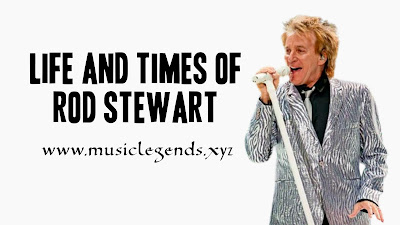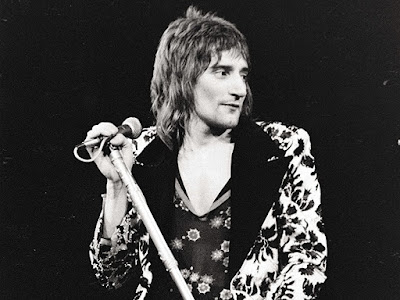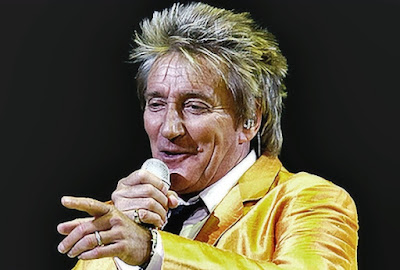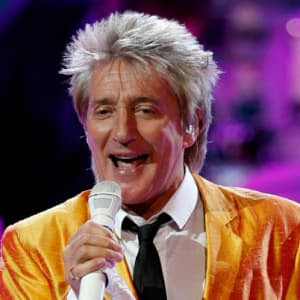The Ragged Voice That Conquered the World: Sir Rod Stewart
Close your eyes and imagine it: that raspy, gravelly, impossibly soulful voice cutting through the air, telling stories of lost love, wild nights, and heartfelt devotion. A voice that sounds like it's been soaked in whisky and cured in cigarette smoke, yet can deliver a ballad so tender it breaks your heart. This is the voice of Sir Roderick David Stewart, the spiky-haired, leopard-print-wearing, football-loving rocker who became one of the best-selling music artists of all time. From his humble beginnings in post-war North London to selling out stadiums worldwide, Rod Stewart's journey is a masterclass in resilience, reinvention, and raw talent. He's the soccer hooligan who became a knight, the busker who became a billionaire, and the man with a voice so distinctive you can recognize it from the very first note. So, grab a drink, settle in, and let's take a deep, colorful dive into the life and times of the one and only Rod Stewart.
I will be embedding a specially curated Spotify playlist of Rod Stewart's greatest hits right here! Stay tuned to listen along as you read.
Chapter 1: The Young Rascal - A Post-War Childhood in North London
Roderick David Stewart entered the world on January 10, 1945, at 507 Archway Road in Highgate, North London. The youngest of five children born to Robert (a Scottish master builder) and Elsie (an English homemaker), Rod arrived as World War II was drawing to a close. He was the "surprise" baby, born after an eight-year gap following his siblings. The Stewart household was a bustling, working-class home where money was tight but spirit was abundant.
His father, a talented amateur footballer who had once tried out for Scottish club Celtic, initially hoped young Rod would follow in his footsteps. The Stewart family was football-mad, and Rod grew up with a deep, lifelong passion for the beautiful game, particularly for the Scottish national team and Celtic FC. But while he had some skill on the pitch, another passion was brewing.
Young Rod was not academically inclined. He struggled through primary school and most of secondary school, eventually dropping out at the age of 15 with few qualifications and even fewer prospects. But he had two things going for him: an irrepressible personality and a growing obsession with American music. He would spend hours listening to the raw folk of Woody Guthrie, the early rock and roll of Little Richard, and the protest songs of Bob Dylan. In 1959, recognizing this spark, his father bought him his first guitar – a life-changing moment that set a shy, unassuming boy on the path to becoming a global icon.
The First Bands: From the Kool Kats to a Harsh Reality Check
In 1960, Rod joined his first band, The Kool Kats. They were a typical teenage group of the era, playing repertoires of Rock and Roll covers at local youth clubs and church halls. It was here that Rod first began to develop his stage presence, albeit a clumsy one. He was finding his feet, but he had big dreams.
In 1961, he attended a fateful audition on Denmark Street – London's "Tin Pan Alley" – with the notoriously eccentric producer Joe Meek. Rod, brimming with teenage confidence, believed he was destined for stardom. The reality was a brutal wake-up call. Partway through his audition, Meek abruptly cut him off, muttering dismissively that he saw no future for the young singer. He was told to give up and go back to his day job.
This rejection could have crushed him. Instead, it fueled him. Rod took it as a challenge. He spent the next two years in intense musical self-education, holed up in his bedroom, obsessively studying the phrasing of Sam Cooke, the folk storytelling of Bob Dylan, and the harmonica techniques of Sonny Boy Williamson. He was no longer just a kid who liked to sing; he was an apprentice mastering his craft.
The Mod Father: Forging an Image and a Sound
By 1963, Rod had re-emerged, transformed. He had not only honed his vocal skills but had also mastered the harmonica. More importantly, he had crafted an image. He fully embraced the Mod subculture – the sharp, Italian-inspired suits, the Anello & Davide boots, the meticulously styled hair. He was no longer just a singer; he was a style icon in the making.
His big break came when he joined the R&B group The Dimensions as a singer and harmonica player. This was his first professional gig, and it placed him right at the heart of London's burgeoning music scene. The band became the resident act at the legendary Studio 51 club in Soho, a hangout for the likes of The Rolling Stones. It was here that Rod's reputation began to grow. He studied Mick Jagger's stage moves and harmonica style, absorbing everything he could from the rising stars around him.
His unique, raspy voice – a complete departure from the clean-cut pop singers of the early 60s – began to turn heads. He was soon recruited by legendary blues singer Long John Baldry for his band, The Hoochie Coochie Men, and later joined the influential group Steampacket alongside Julie Driscoll and Brian Auger. Rod was paying his dues in the trenches of the British R&B scene, and his talent was becoming impossible to ignore.
Chapter 2: The Breakthrough - From Jeff Beck to "Maggie May"
The pivotal moment in Rod's early career came when he joined the Jeff Beck Group in 1967. Alongside bassist Ron Wood, this band became a prototype for hard rock. Rod's powerful, soul-infused vocals were the perfect match for Beck's blistering guitar work. They released two landmark albums, Truth (1968) and Beck-Ola (1969), which were critically acclaimed and hugely influential. For the first time, Rod was playing to international audiences, and his voice was being heard across the Atlantic.
In October 1968, through the help of his friend Lou Reizner, Rod signed his first solo contract with Mercury Records. He began working on his debut solo album while still with Beck, showing an ambition that would define his career. However, creative tensions and Rod's growing star power led to the dissolution of the Jeff Beck Group in 1969.
Suddenly a free agent, Rod was quickly snapped up by his bandmate Ron Wood to join The Small Faces, who became simply The Faces. This was the perfect vehicle for Rod's raucous, good-time personality. The Faces were the ultimate party band – loud, messy, and incredibly fun. While with The Faces, Rod continued his solo career, and in 1971, he released the album Every Picture Tells a Story.
The album contained a song that would change everything. "Maggie May," a semi-autobiographical tale of a young man's relationship with an older woman, started as a B-side. But radio DJs flipped the single, and the rest is history. Driven by its unforgettable mandolin riff and Rod's heartfelt, world-weary vocal, "Maggie May" exploded, reaching number one on charts on both sides of the Atlantic. Almost overnight, Rod Stewart went from being a respected rock singer to a global superstar.
TOP 36 ROD STEWART SONGS PLAYLIST [VIDEO]
The Solo Superstar: "You're In My Heart" and the Move to America
The success of "Maggie May" was no fluke. Rod followed it with a string of classic 70s albums that defined the era: Never a Dull Moment (1972), Smiler (1974), and Atlantic Crossing (1975). The latter was a symbolic title, marking his move to Los Angeles and a conscious effort to crack the American market. He teamed up with producer Tom Dowd and began incorporating a more polished, soul-influenced sound, resulting in timeless hits like "Sailing," "Tonight's the Night," and "You're In My Heart."
His stage persona was now fully formed: the spiky, peroxided hair, the tight trousers, the leopard-print jackets, and the ever-present football that he would kick into the audience during shows. He was a rock star in the grandest sense, living a life of legendary excess but always managing to channel it into his music. Throughout the 70s, he achieved a remarkable feat: his first six solo albums all reached number one in the UK charts, a record that stands to this day.
Chapter 3: The Man Behind the Microphone - Cars, Kids, and Knighthood
Rod Stewart's personal life has always been as colorful as his stage wardrobe. He is famously a connoisseur of beautiful women and fast cars. His love affair with automobiles is the stuff of legend. He owns one of only 400 limited-edition Ferrari Enzos ever made, and his car collection is worth tens of millions. In 1982, he was famously car-jacked in Los Angeles while parking his $50,000 Porsche (which was thankfully recovered).
He is also a prolific father, having eight children with five different women, ranging from model Alana Hamilton to current wife Penny Lancaster. His large, blended family is a central part of his life, and he often speaks with pride about his role as a father. Despite his rock and roll lifestyle, he has maintained strong relationships with most of his children.
In a testament to his enduring legacy and contribution to British culture, Rod Stewart has been formally recognized by his country. He was appointed a Commander of the Order of the British Empire (CBE) in 2007 and was knighted in 2016, officially becoming Sir Rod Stewart. For the boy from the Archway Road, it was an unimaginable honor, proof that the ragged voice and rebellious spirit had earned its place in the establishment.
The Legacy: Awards, Accolades, and an Unforgettable Voice
Rod Stewart's career is a case study in longevity and adaptability. He has successfully navigated musical trends for over five decades, from blues-rock to disco in the late 70s ("Da Ya Think I'm Sexy?"), to synth-pop in the 80s, and a triumphant return to his roots with his massively successful series of The Great American Songbook albums in the 2000s.
His trophy cabinet is a reflection of his impact:
Major Awards & Honors
- Brit Award for Outstanding Contribution to Music (1993)
- Inducted into the Rock and Roll Hall of Fame (1994 as a solo artist, and 2012 as a member of The Faces)
- Grammy Award for Best Traditional Pop Vocal Album (2005 for Stardust... The Great American Songbook Volume III)
- Received the first ever Diamond Award from the World Music Awards (2001) for selling over 100 million records worldwide.
- Inducted into the UK Music Hall of Fame (2006)
- Appointed Commander of the Order of the British Empire (CBE) (2007)
- Knighted by Queen Elizabeth II (2016)
Perhaps the greatest compliment came from the Godfather of Soul himself, James Brown, who in 2006 called Rod Stewart music's "best white soul singer." With over 200 million records sold, he remains one of the best-selling artists in history.
The Final Chorus: Forever Young
What is the secret to Rod Stewart's enduring appeal? It's the combination of that one-in-a-million voice, a peerless knack for melody, and a everyman quality that makes you feel like he's singing directly to you. He's a rock god who never lost the common touch. Whether he's singing a heartfelt ballad like "Have I Told You Lately" or a raucous anthem like "Stay With Me," there is an authenticity that cuts through.
From the Mod clubs of London to the stadiums of the world, from the rejection of Joe Meek to the honor of knighthood, Rod Stewart's journey is a testament to the power of self-belief and sheer, uncompromising talent. He is, and will always be, the ragamuffin who made good, the voice of a generation, and a true legend of rock and roll.
Let's Get Interactive: The Rod Stewart Listening Challenge!
As you listen to the YouTube playlist above, here's a game to play:
- Track the Rasp: Listen to his early work with the Jeff Beck Group, then jump to "Maggie May," and then to "Da Ya Think I'm Sexy?" Can you hear how his signature rasp evolved and was adapted to different genres?
- Spot the Soul: Listen to his covers of soul classics like "(I Know) I'm Losing You" or "This Old Heart of Mine." How does he make these songs his own while paying homage to the originals?
- The Storyteller: Pay close attention to the lyrics in "Maggie May" and "The Killing of Georgie." How does he use narrative to create vivid, emotional pictures?
We'd love to hear from you! What is your favorite Rod Stewart era? Is it the blues-rock of the Jeff Beck Group, the folk-rock storytelling of the early 70s, or the polished pop of the 80s? What's your all-time favorite Rod Stewart song? Share your memories and thoughts in the comments below!







No comments: